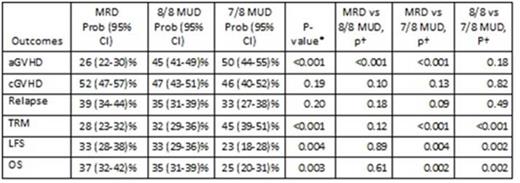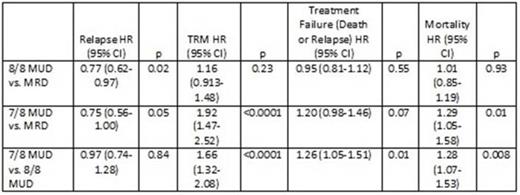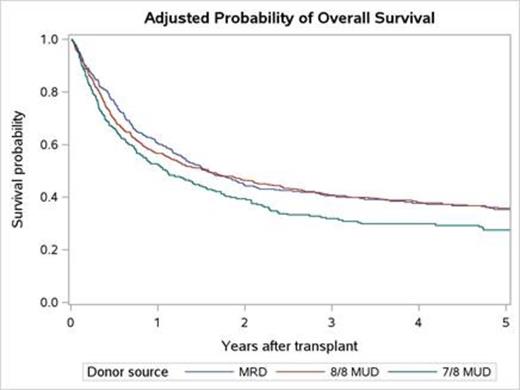Abstract
Allogeneic hematopoietic cell transplantation (HCT) is a potentially life-saving treatment for patients with acute lymphoblastic leukemia (ALL). About one-third of patients have a human leukocyte antigen (HLA) matched related donor (MRD), while the remaining two-thirds have either a fully HLA-matched (HLA-A, -B, -C, -DRB1 [8/8]) unrelated donor (MUD) or a MUD with a single HLA mismatch (7/8). Previous analyses by the CIBMTR have shown that MRD and MUD transplants produce similar survival outcomes for patients with acute myelogenous leukemia (AML) (Blood 2012; 119(17):3908-16), while donor source was an important predictor of outcomes in patients with myelodysplastic syndrome (MDS) (Blood 2013; 122(11):1974-82). Given that ALL represents the second most common indication for HCT, and recognizing the disease-specific nature of the impact of donor source on post-HCT outcomes previously described, we performed an analysis of outcomes after MRD versus MUD HCT in 1458 patients with ALL who underwent allogeneic HCT from 2000-2011 (MRD n=440, 8/8 MUD n=729, 7/8 MUD n=289). Median age was 37 years (18-69). Thirty-four percent were Philadelphia chromosome positive.Ten percent received reduced intensity conditioning (RIC). Twenty-three percent were transplanted in second complete remission (CR2).Seventy-four percent received peripheral blood stem cells. At 100 days post-HCT, the incidence of acute GVHD Grade B-D was significantly lower in MRD recipients than in 8/8 MUD or 7/8 MUD recipients (26%, 45%, 50%, respectively; p<0.001). In multivariate analysis, 8/8 MUD recipients had similar rates of transplant-related mortality (TRM) and overall survival (OS) (hazard ratio [HR] 1.16, p=0.225and HR 1.01, p=0.93, respectively) compared to MRD recipients; 7/8 MUD recipients had inferior TRM and OS when compared to both MRD recipients (HR 1.92, p<0.001 and HR 1.29, p=0.01, respectively) and 8/8 MUD recipients (HR 1.66, p<0.001 and HR 1.28, p=0.008, respectively).Recipients of peripheral blood transplants had inferior long-term survival (>24 months post-HCT) (HR=2.13, p=0.003) compared to bone marrow transplants. Compared to MRD, 8/8 MUD recipients had superior relapse rates (HR 0.77, p=0.02), while 7/8 MUD recipients had no difference (HR 0.75, p=0.05). There were no differences in leukemia-free survival (LFS) comparing 8/8 MUD recipients (HR 0.95, p=0.55) and 7/8 MUD recipients (HR 1.20, p=0.07) to MRD recipients (Table 2, Figure 1).Differences in survival were likely due to higher rates of acute GVHD and TRM in the 7/8 MUD group. We conclude that MRD and 8/8 MUD recipients have similar survival outcomes post-HCT, while 7/8 MUD recipients suffer inferior survival, demonstrating that donor source plays a large role in the quality of outcomes. While MRD remains the ideal donor source due to its lower incidence of acute GVHD,HCT from an 8/8 MUD is a good alternative to MRD transplant, given its comparable long-term survival outcomes.
100-day Cumulative Incidence of Acute GVHD; 5-year Cumulative Incidence of chronic GVHD, relapse, and TRM; 5-year Probabilities of LFS and OS in Adult ALL Patients Receiving MRD, 8/8 MUD, or 7/8 MUD HCT from 2000-2011 *Overall point-wise comparison † Point-wise pair-wise comparison
100-day Cumulative Incidence of Acute GVHD; 5-year Cumulative Incidence of chronic GVHD, relapse, and TRM; 5-year Probabilities of LFS and OS in Adult ALL Patients Receiving MRD, 8/8 MUD, or 7/8 MUD HCT from 2000-2011 *Overall point-wise comparison † Point-wise pair-wise comparison
Multivariate Analysis for Relapse, TRM, Treatment Failure (Inverse of LFS), and All-Cause Mortality (Inverse of Overall Survival) in Adult ALL Patients Receiving MRD, 8/8 MUD, or 7/8 MUD HCT from 2000-2011.
Multivariate Analysis for Relapse, TRM, Treatment Failure (Inverse of LFS), and All-Cause Mortality (Inverse of Overall Survival) in Adult ALL Patients Receiving MRD, 8/8 MUD, or 7/8 MUD HCT from 2000-2011.
Adjusted Overall Survival Estimatesfor Adult ALL Patients Receiving MRD, 8/8 MUD, or 7/8 MUD HCT
Adjusted Overall Survival Estimatesfor Adult ALL Patients Receiving MRD, 8/8 MUD, or 7/8 MUD HCT
Sandmaier:Gilliad: Honoraria; ArevaMed: Honoraria; Jazz Pharmaceutical: Honoraria; Seattle Genetics: Honoraria; Abmit: Research Funding; Bellicum: Research Funding.
Author notes
Asterisk with author names denotes non-ASH members.




This feature is available to Subscribers Only
Sign In or Create an Account Close Modal